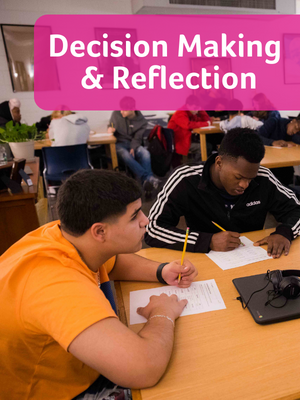Life is a journey marked by a series of decisions, each with the power to shape our experiences, opportunities, and the paths we navigate. Whether big or small, the choices we make carry the weight of consequence and the potential for growth. At the heart of this intricate process lies the art of decision making, reflection, and refinement – processes that when we string them together takes us on a journey that influences the course of our lives.
Making good choices is not an automatic process that we are born with. It is a process many of us learn through trial and error. We often reference the school of hard knocks, but what if schools explicitly taught the process, helping us string them together intentionally?
The Decision Making Process

Decision making is a thought process we engage in daily, from the small matters like choosing breakfast cereal to the profound choices that can alter the trajectory of our education or relationships. The process involves a
multitude of factors, often including our values, desires, emotions, rational thinking, and external influences.
- Identifying the Decision: The journey begins with recognizing the need for a decision. It might be prompted by an external event or an internal realization that change is required.
- Gathering Information: Once aware of the decision at hand, we collect relevant information. This might entail research, seeking advice, or drawing from our own experiences.
- Weighing Options: With information in hand, we identify and evaluate available options. Each choice holds its own set of pros and cons, resonating differently with our goals and values.
- Considering Emotions: Whether we realize it or not, emotions play an important role in our decision-making process. We often lean on our gut feelings or intuition, which can offer insights and potential traps as part of our analysis.
- Thinking the Solution Through: Reasoning and logic bring structure to our choices. This step involves assessing the potential outcomes and aligning them with our long-term goals and objectives.
- Making the Choice: The culmination of the process results in a decision. This is where the course of action is selected, setting us on a specific path.
Reflection: The Companion of Decision Making
Reflection is the companion that walks hand in hand with decision making, offering a space for introspection, evaluation, and growth. It involves looking back at the choices we’ve made, understanding their impact, and learning from our experiences.
- The Pause for Contemplation: After a decision is made and its consequences begin to unfold, taking a moment to pause and reflect is essential. This pause allows us to detach from the immediate emotions and gain perspective.
- Analyzing the Outcome: Reflection involves an honest evaluation of the outcome – did the decision lead to the expected results? If not, why? This examination isn’t about assigning blame but understanding the dynamics at play.
- Learning Opportunities: Every decision carries a lesson, regardless of whether it yields success or challenges. Reflecting on these lessons nurtures personal growth and helps refine future decision-making processes.
- Refinement: Reflection often leads to the realization that adjustments are needed. These could range from minor tweaks in approach to an entirely new path. The flexibility to adapt is a hallmark of effective decision makers.
- Adjustment: Once reflection indicates a need to adjust our approach, we go through the decision making process again, this time with new updated information that allows us to choose a different more effective path.
- Acknowledging Emotional Responses: Reflection isn’t solely intellectual; it involves recognizing and processing the emotions that arise from the outcome of a decision. This emotional awareness can help us learn how to manage our responses more effectively.
- Reinforcing Self-Trust: Positive reflections reinforce our ability to make sound decisions. Trust in oneself grows as we acknowledge the wisdom gained from past choices.
The Symbiotic Relationship
The process of decision making, reflection and refinement is a symbiotic relationship, each influencing the other in a continuous loop. Decision making informs our reflections, and reflections inform refinement and future decision making. This dynamic interplay is what helps us refine our judgment, enhance our self-awareness, and ultimately shape the trajectory of our lives.
In a world of uncertainty and complexity, mastering the art of decision making and reflection is a skill that empowers us to navigate life’s crossroads with intentionality and grace. It’s not a linear process but rather a dance that requires practice, patience, and a willingness to embrace both success and failure as part of the journey. So, as we step onto the floor of choices, let us remember that every step – every decision and every reflection – contributes to the masterpiece that is our life.
At CTL, we don’t expect students to come to school with these skills and processes in place, but we do believe schools can and should help explicitly support their development. Our Critical Reflection Process is an integral componenet of our Postsecondary Success Skills Model and is how we help schools and teachers, operationalize the development of the skills they need to be successful post graduation.
